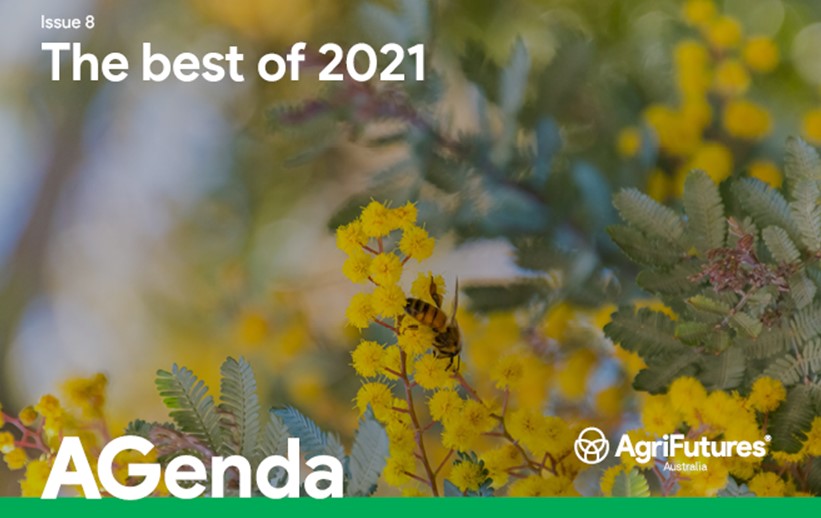AgriFutures - AGenda newsletter - Issue 8

Welcome to AgriFutures AGenda and a very happy New Year to you.
From the launch of growAG. to improving pollination by developing web-based resources for beekeepers; 2021 saw our organisation overcome the challenges and hurdles that COVID-19 threw at us with spectacular results for our industries.
As we reflect on the past 12 months, we are heartened by the producers, researchers and rural industries who, renowned for their resilience and responsiveness, have once again been able to see and think beyond the challenges of the past year, to have the strength and courage to visualise a better, brighter future.
In this month’s AGenda, we bring you the best stories from 2021. What carries the success of an emerging industry? What innovations will drive the sustainability of our sector? What leadership lessons can we learn from one another? Here’s our pick of some of the highlights from the year which we have recently bid farewell.
What's the non-financial critical factor for our emerging industries' success?
How did the export fodder industry grow from an emerging industry to a highly profitable and competitive player within the grain sector, with an industry-wide RD&E Levy? And the seaweed industry; what has been the driving force behind the development and change needed to accelerate real impact?
We reveal the fundamental factor needed to grow Australia's emerging industries - and it's something that very much needs to be front of everyone's minds.
"It's something that everyone in agriculture needs to be aware of, and act now."
How much additional capital is needed to reach the National Farmers’ Federation’s target of growing Australian agriculture to $100 billion by 2030? And where will this additional capital come from? These are the two questions Natural Capital Economics addressed.
Speaking about the widely read report, AgriFutures Australia Managing Director John Harvey stresses that bridging the investment gap needs to happen quickly.
Innovative plastic mulch set to increase crop water productivity by 30 per cent
With experts predicting we’ll need to feed and clothe 9.7 billion people by 2050, agricultural production must undergo a radical transformation. CSIRO has developed a game-changing update to a decades-old technology that will enable the sustainable intensification needed to produce more food with less resources. evoke AG has the details.
Catherine Marriott on leadership and what really matters
Catherine Marriott was the 2012 National Rural Women’s Award Runner Up, she’s a Chief Executive Officer, a board director, a graduate of the Australian Rural Leadership Program, and has been a Councillor, a Commissioner, a keynote speaker and a facilitator. But none of the “shiny stuff” matters to her. For Catherine, all that she is and all that she does comes down to one thing: a love for people.
Keeping the Australian rice industry competitive
A six-year research project has recommended Australian rice growers move towards drill sowing and delayed permanent water as standard practice in order to remain competitive and profitable and to help the industry achieve its target of 1.5 tonnes of rice per megalitre of water by 2026.
Looking to the past for a sustainable future
"There is renewed interest around the world in going back to sustainable farming methods using pasture plants to put nitrogen back into the soil. We’re rapidly seeing technology completely alter the way things work and I’m keen to be a part of that in agriculture, to address some of the issues faced by the subclover industry." - Wesley Moss, The University of Western Australia, PhD candidate.
World leading autonomous beehive
“We don’t interfere in the biology of the pollination of the bees or the production of their honey. What we do is ensure that back home in the hive the environment is productive to them so they can thrive. We regulate the temperature and the humidity for their benefit, and we help them with disease in the hive and the robot can identify that and apply treatment in real time.” - Saar Safra, BeeWise, CEO.
What does it take to build a workforce for the future?
“We are moving towards areas like robotic engineering and digitally connecting our supply chains and value chains. I think these technological advances will make the parameters of the workforce requirements very different to what we traditionally had, which is making the industry even more attractive.” - Josh Whelan, Meat & Livestock Australia, Program Manager, Innovation Capability.
Was this email forwarded to you? Sign up to receive future AGenda newsletters!
News articles
Copyright 2024 - All Rights Reserved